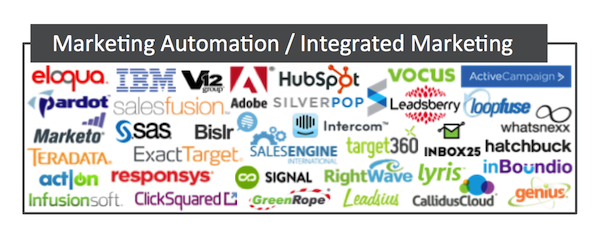
I started working on a new version of a marketing landscape that will be released early next month. The last one I did was back in 2012, and a lot has happened since then.
One thing in particular that has surprised me in my research is how much the marketing automation category has expanded. While I’ve expected the overall marketing technology space to expand, I’ve largely subscribed to the narrative that the marketing automation category within it is consolidating. (My belief is that marketing automation systems will evolve to be more open platforms that accelerate the growth of diverse marketing apps at the next layer up.)
Indeed, there have been some major acquisitions — Oracle acquired Eloqua, Salesforce.com acquired ExactTarget and Pardot, Adobe acquired Neolane. Marketo had a successful IPO, and its stock has risen by 42% this year to a $1.2 billion market cap. And more M&A and IPOs are likely in the year ahead. That is the narrative of consolidation.
UPDATE: Just as I posted this, the news came out that Oracle had acquired Responsys. HT to Brian Bachofner for alerting me to this.
But several counter-narratives have emerged too.
A new wave of vendors have launched in this space — the second-generation of marketing automation: Bislr, Leadsius, inBoundio, Whatsnexx, Intercom, Inbox25, and more.
Not all of these fit the mold as defined by the first generation of marketing automation. You could argue that products like Intercom are more of an alternative to marketing automation. The SMB segment of the market is particularly diverse with products that cross boundaries from traditional labels.
I’ll have more — a lot more — to rant say about categories and labels when I release the new landscape. However, labels aside, these products are all largely playing in the same pool. So while acknowledging that “marketing automation / integrated marketing” is a big and fuzzy designation, this cluster of vendors is largely competitive with each other.
Which leads to another important counter-narrative. Another major category of marketing software — what started out as web content management (WCM) but is evolving into web experience management (WEM) — is increasingly overlapping with the capabilities of products in the marketing automation space (and vice versa). You could argue that the long-term effect of this may be consolidation, but there’s no doubt that the short-term effect is an expansion of choices in the space.
I expect we’ll see a lot more cross-category competition among these vendors in 2014:


And there’s yet another counter-narrative, with more specialized kinds of marketing automation receive more attention — in particular, marketing automation designed for channel and partner marketing, companies such as TreeHouse, Marketing Advocate, Zift Solutions, and others.
In turn, this emerging channel marketing automation category is intertwining with many marketing resource management (MRM) vendors. Meanwhile, some marketing automation providers like Marketo are making a strong push to incorporate MRM capabilities into their platforms.
It’s looking like a red ocean.
But the truth is, despite all this competition, the market for marketing automation solutions — if we use that label loosely — is large and growing larger. As David Cummings wrote earlier this year, the numbers suggest that we’re just at the beginning of the coming wave of marketing automation adoption.
As David points out, the math would suggest that we’ve only seen about 5% adoption of the potential market. This means that the pie can grow tremendously, even as more contenders seek to have a slice. Those economics can support a diverse field of competitors for quite some time.
Which is why I believe we’re going to see a super-collider effect of marketing automation in 2014. It will be spectacular, and I expect there will be many new discoveries.
In the meantime, I have two recommendations:
Read this post from Jay Famico of SiriusDecisions on How Marketing Automation Has Evolved in 2013. It’s a terrific summary of how much has changed in the past 12 months.
Read everything from this past year on David Raab‘s Customer Experience Matrix blog. In my opinion, David is one of the best authorities on marketing automation (and related categories), and he’s extremely generous in the depth of his analysis that he provides for free on his blog.
With any luck, this is my last post for 2013. Thank you for reading this year. I hope you have happy holidays and that your New Year kicks off to a great start.
P.S. If you feel I missed a company that should be represented in one of the categories above, please let me know in the comments. No promises, but I’ll be working on the big jigsaw puzzle of the landscape over the holidays — it’s odd that I find that pleasantly relaxing — and will try to squeeze in whomever I can before the final release in January.




Hello Scott –
For your next marketing landscape, please include Right On Interactive! We were mentioned in Jay Famico’s article you mentioned above and are also included in David Raab’s VEST report.
Regards,
Troy Burk
CEO
Right On Interactive
Hi, Troy.
Sorry I missed you in this draft — thanks for letting me know. Yes, I’ll make sure you’re in the landscape that goes out in January.
Best,
Scott
Please feel free to include SimplyCast too – not sure how much you know about us, but I’d be glad to discuss anytime.
http://www.simplycast.com/
[email protected]
Ariel Hopper
Director, Reseller Services
SimplyCast
Yes, I was just reading up on SimplyCast. Sounds like a great product. I’ve added that into the landscape that will be released in January. Thanks!
Thanks Scott – look forward to reading it!
Thanks Scott- looking forward to seeing the latest landscape when you publish in January.
Regards,
Troy Burk